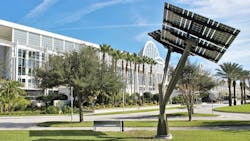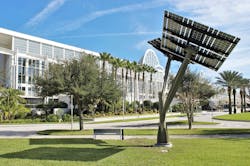Last month, I attended POWER-GEN International, billed as the world’s largest power-generation event. Though POWER-GEN is not on par with the AHR Expo in terms of relevance to the HVACR industry, I found—as in previous years—a significant number of products and services of interest. For example, the boiler industry was well-represented, with many of the same manufacturers that exhibit at the AHR Expo present. Chillers were not on display, but there was a plethora of ancillary and support exhibitors—water-treatment providers, cooling-tower manufacturers, and even refrigerant service companies—present. There also were fans, ductwork, and controls on display. As one would expect, because piping is critical to the power-generation industry, pipe hangers for power piping—many also suitable for condenser- and chilled-water-piping support—were prevalent. If you’re interested in power-generation-related technologies that may also have application in the HVACR space, POWER-GEN is a great place to see what’s new.
As an energy and sustainability consultant with a strong professional interest in renewable energy, especially solar, I find the Renewable Energy World portion of POWER-GEN of particular importance. One exhibitor I was especially looking forward to visiting actually exceeded my expectations. Spotlight Solar manufactures architectural solar-photovoltaic (PV) structures called “solar trees.” High-efficiency solar-PV panels are integrated into steel structures resembling trees, a signifier of their owners being leaders in renewable-energy adoption and environmental stewardship.
Spotlight Solar offers several styles of solar trees, such as lifts, curves, and trestles of various sizes, typically with one to four panels per structure. They are designed for both high-velocity hurricane zones, like we have here in South Florida, and the seismic conditions found in places such as California. Unlike traditional solar-PV installations, they are aesthetically pleasing, as they look like sculptures and come powder-coated in one of more than 200 colors.
The solar trees can incorporate educational or brand signage, can be integrally lit, and are ideal for providing power to other environmentally friendly devices, such as electric-car charging stations. Though expensive compared with conventional roof-mounted arrays, they can point visitors to a building’s larger PV installation, which might otherwise go unnoticed. For example, the solar tree installed in front of the Orange County (Florida) Convention Center was provided by the Orlando Utilities Commission (OUC) and bears a sign reading: “This solar tree can power an electric vehicle for 15,000 miles per year. But that’s a tiny fraction of the solar energy OUC is providing around Orlando.” The convention center itself is certified LEED Gold and has a 1-megawatt PV system on its roof, which provides approximately 3 percent of the North-South Building’s energy, which most visitors never learn about.
For building owners who want to appeal to environmentally conscious visitors and employees, solar trees could be part of a successful educational and public-relations strategy.
About the Author
Larry Clark
A member of HPAC Engineering’s Editorial Advisory Board, Lawrence (Larry) Clark, QCxP, GGP, LEED AP+, is principal of Sustainable Performance Solutions LLC, a South Florida-based engineering firm focused on energy and sustainability consulting. He has more than two dozen published articles on HVAC- and energy-related topics to his credit and frequently lectures on green-building best practices, central-energy-plant optimization, and demand-controlled ventilation.

